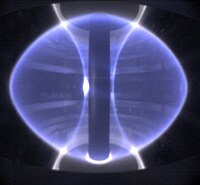
Photo from wikipedia
Abstract Tungsten (W) will be used as material for plasma-facing components (PFCs) in the divertor of ITER and interact with Helium (He) ions either from initial He plasma operation or… Click to show full abstract
Abstract Tungsten (W) will be used as material for plasma-facing components (PFCs) in the divertor of ITER and interact with Helium (He) ions either from initial He plasma operation or from Deuterium-Tritium (DT) fusion reactions in the active operation phase. Laboratory experiments reported that in a specific operational window of impact energy, ion fluence, and surface temperature (Ein ≥ 20 eV, ϕ ≥ 1 × 1024 He + m B t = 2.5 T , I p = 0.8 M A , P a u x ≃ 8.0 M W Tsurf ≥ 1000 K) a modification of W surfaces occurs resulting in the formation of He-induced W nanostructures. Experiments in ASDEX Upgrade H-mode plasmas ( E i n = 37 k e V T, ϕ ≃ 0.75 × 10 24 H e 0 m − 2 MA, Paux ≃ 8.0 MW) in He have been carried out to investigate in detail (a) the potential growth of W nanostructures on pre-damaged W samples incorporating He nanobubbles, and (b) the potential ELM-induced erosion of W nanostructure. Both W surface modifications were generated artificially in the GLADIS facility by He bombardment of W samples at ϕ ≃ 1 × 10 24 H e 0 m − 2 keV (a) to ϕ ≃ 0.75 × 1024 He0m ϕ ≃ 1.6 × 10 24 H e + m − 2 at Tsurf ≃ 1800 K and (b) ϕ ≃ 1 × 1024 He0m − 2 at Tsurf ≃ 2300 K prior to exposure in the divertor manipulator of ASDEX Upgrade. Though in part (a) conditions of W nanostructure growth with a total He ion fluence of ϕ ≃ 1.6 × 1024 He + m − 2 and peak He ion impact energies above 150 eV were met, no growth could be detected. In part (b) lower density plasmas with more pronounced type I ELMs, carrying energetic He ions in the keV range, were executed with the strike-line positioned on 2 µm thick W nanostructure accumulating a fluence of ϕ ≃ 0.8 × 1024 He + m − 2 . Post-mortem analysis revealed that co-deposition by predominantly W, and Boron (B), eroded at the main chamber wall and transported into the divertor, took place on all W samples. Erosion of W nanostructure or its formation was hindered by the fact that the outer divertor at the location of the samples was turned under these He plasma conditions into a net deposition zone by W, B and Carbon (C) ions. The surface morphology with large roughness and effective surface area act as a catcher for the impinging impurities. Thus, apart from operation in the existence diagram of W nanostructure with respect to Tsurf, ϕ, and Ein, also the impinging impurity flux contribution needs to be considered in predictions concerning the formation of W nanostructures.
Journal Title: Nuclear materials and energy
Year Published: 2017
Link to full text (if available)
Share on Social Media: Sign Up to like & get
recommendations!